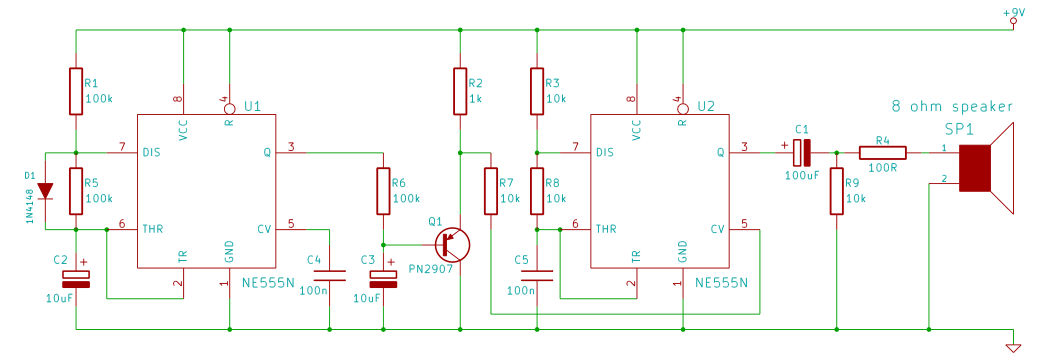
Siren

An electronic siren made from discrete components. The sound produced imitates the rise and fall of an American police siren. When first switched on the 10u capacitors is discharged and both transistors are off. When the push button switch is pressed to 10u capacitor will charge via the 22k resistor. This voltage is applied to the base of the BC108B which will turn on slowly. When the switch is released the capacitor will discharge via the 100k and 47k base resistors and the transistor will slowly turn off. More: The change in voltage alters the frequency of the siren. The oscillator action is more difficult to work out. As the BC108B transistor switches on its collector voltage falls and so the 2N3702 transistor is switched on. This happens very quickly.
The described electronic siren circuit utilizes discrete components to create a sound that mimics the characteristic rise and fall of an American police siren. The circuit's operation begins with the initial state where both transistors—BC108B and 2N3702—are off due to the discharge of a 10 µF capacitor. This capacitor is pivotal in controlling the timing and frequency of the siren sound.
Upon pressing the push button switch, the 10 µF capacitor begins to charge through a 22 kΩ resistor. The voltage across the capacitor increases gradually, which is reflected at the base of the BC108B transistor. As the voltage reaches the threshold level, the BC108B starts to turn on slowly, allowing current to flow through its collector to emitter path. This gradual turn-on process contributes to the rising sound of the siren.
When the push button switch is released, the capacitor begins to discharge through two resistors: a 100 kΩ resistor and a 47 kΩ resistor. This discharge process results in a decrease in base current to the BC108B transistor, causing it to turn off slowly. The timing of this discharge is crucial, as it directly influences the frequency of the siren sound produced.
The operation of the second transistor, 2N3702, is linked to the behavior of the BC108B. As the BC108B turns on and its collector voltage drops, the 2N3702 transistor is activated. This transistor acts as a secondary switch, enhancing the oscillation effects and contributing to the siren sound's modulation. The rapid switching of the 2N3702 allows for a quick response in the sound output, producing the characteristic oscillation of the siren.
The frequency modulation of the siren sound is achieved through the interplay of the charging and discharging cycles of the capacitor, alongside the dynamic switching of the two transistors. As the voltage changes across the capacitor, the oscillation frequency adjusts, creating the desired siren effect. This circuit exemplifies how discrete components can be effectively utilized to replicate complex sound patterns through simple electronic principles.An electronic siren made from discrete components. The sound produced imitates the rise and fall of an American police siren. When first switched on the 10u capacitors is discharged and both transistors are off. When the push button switch is pressed to 10u capacitor will charge via the 22k resistor. This voltage is applied to the base of the BC108B which will turn on slowly. When the switch is released the capacitor will discharge via the 100k and 47k base resistors and the transistor will slowly turn off. The change in voltage alters the frequency of the siren. The oscillator action is more difficult to work out. As the BC108B transistor switches on its collector voltage falls and so the 2N3702 transistor is switched on. This happens very quickly ( less th 🔗 External reference
The described electronic siren circuit utilizes discrete components to create a sound that mimics the characteristic rise and fall of an American police siren. The circuit's operation begins with the initial state where both transistors—BC108B and 2N3702—are off due to the discharge of a 10 µF capacitor. This capacitor is pivotal in controlling the timing and frequency of the siren sound.
Upon pressing the push button switch, the 10 µF capacitor begins to charge through a 22 kΩ resistor. The voltage across the capacitor increases gradually, which is reflected at the base of the BC108B transistor. As the voltage reaches the threshold level, the BC108B starts to turn on slowly, allowing current to flow through its collector to emitter path. This gradual turn-on process contributes to the rising sound of the siren.
When the push button switch is released, the capacitor begins to discharge through two resistors: a 100 kΩ resistor and a 47 kΩ resistor. This discharge process results in a decrease in base current to the BC108B transistor, causing it to turn off slowly. The timing of this discharge is crucial, as it directly influences the frequency of the siren sound produced.
The operation of the second transistor, 2N3702, is linked to the behavior of the BC108B. As the BC108B turns on and its collector voltage drops, the 2N3702 transistor is activated. This transistor acts as a secondary switch, enhancing the oscillation effects and contributing to the siren sound's modulation. The rapid switching of the 2N3702 allows for a quick response in the sound output, producing the characteristic oscillation of the siren.
The frequency modulation of the siren sound is achieved through the interplay of the charging and discharging cycles of the capacitor, alongside the dynamic switching of the two transistors. As the voltage changes across the capacitor, the oscillation frequency adjusts, creating the desired siren effect. This circuit exemplifies how discrete components can be effectively utilized to replicate complex sound patterns through simple electronic principles.An electronic siren made from discrete components. The sound produced imitates the rise and fall of an American police siren. When first switched on the 10u capacitors is discharged and both transistors are off. When the push button switch is pressed to 10u capacitor will charge via the 22k resistor. This voltage is applied to the base of the BC108B which will turn on slowly. When the switch is released the capacitor will discharge via the 100k and 47k base resistors and the transistor will slowly turn off. The change in voltage alters the frequency of the siren. The oscillator action is more difficult to work out. As the BC108B transistor switches on its collector voltage falls and so the 2N3702 transistor is switched on. This happens very quickly ( less th 🔗 External reference





